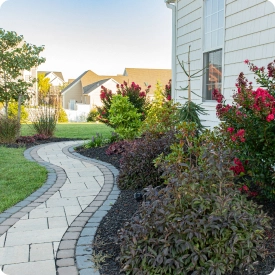Landscape design is a complex process, especially with large-scale projects. The benefits of doing it correctly and avoiding landscaping mistakes in the early design phase exceed personal enjoyment and cost savings on future repairs.
Proper landscape design improves both the appearance and functionality of your outdoor space.
Landscaping fails impact the environment, budget, curb appeal, and property value. Therefore, this article will explain how to avoid the landscaping mistakes and offer a solution for these mistakes.
#1 Neglecting the Long-Term Growth of Plants
One of the most common landscaping mistakes from inexperienced landscapers is not considering the expected plants to grow.
Instead, people plant trees or shrubs, which may look great in the early phases but mess up the entire layout, block views, or crowd other plants over time.
Planting is a complex process that exceeds plant selection and maintenance. The solution for this common mistake is to research or consult an expert gardener on plant size at a mature age.
You should pick plants for your landscape based on their mature size. That way, you can plant enough space for them to grow and distribute other landscape elements according to their space requirements.
#2 Ignoring Sun and Shade Patterns
Bad landscape design doesn’t consider sun and shade patterns. Let’s say you’ve seen the landscape you like, and you copy it for your outdoor space. However, it is a mistake because you’ve not considered your garden’s sun exposure, and you can put sun-loving plants in the shade and shade-loving plants in the sun. That way, none of your plants will thrive.
Spend time in your garden to observe which garden zones have total sun exposure, where there is complete shade, and where the sun is only in the morning. Take notes and plan your species layout according to their light conditions and garden sun exposure.
#3 Forgetting About Drainage
Amateur landscape design only considers the final look of the design and fails to comprehend the drainage needs of your soil.
Drainage-related landscaping mistakes to avoid also include not planning water run-off. The consequences of these residential landscaping mistakes are severe and can include:
- Water pooling
- Erosion issues
- Flooding
- Plant diseases and pest infestation
- Damage to hardscaping elements
There are several drainage options to include in your landscape based on the terrain characteristics and your skills. Try swales or French drains, or use permeable pavers instead of concrete.
Landscape experts can also design grading and slopes to keep the water away from walkways, homes, and garden beds.
#4 Not Planning for Maintenance
Designing your landscaping elements requires more than aesthetic consideration. So, people focused on the beauty of their landscape can neglect the landscape maintenance requirements.
For example, you can create a beautiful landscape that will eventually overgrow and look untidy if you don’t spend much time polishing it, pruning, and caring for the weeds. Eventually, maintenance can become too time-consuming and exceed your budget.
For most busy homeowners, the simple maintenance of their landscapes is as essential as the good-looking ones.
The solution consists of selecting low-maintenance plants and gardening methods to simplify the maintenance.
Here are several tips for incorporating maintenance requirements in the early landscape phase:
- Focus on hardy plants
- Use mulch to reduce weeds
- Design the layout for accessibility
- Decide who will handle maintenance -you or the landscape service company
#5 Overloading the Design with Too Many Features
Are you trying to squeeze in too many elements of landscape and hardscape? Maybe you are buying a tranquility garden with fire pits for socialization surrounded by water features and multiple garden beds? One of the common landscaping mistakes to avoid is overcrowding your landscape.
Messy landscapes limit functionality and ruin the idea of having a beautiful landscape to enjoy outdoor time.
To prevent the mistake, select several crucial landscape elements that are vital to you. Focus on functional and decorative elements such as natural stone pathways, ornamental trees for shade, and mulch for plant protection and tidy appearance.
#6 Poor Use of Scale and Proportion
A common mistake is not considering scale and proportion when designing your outdoor space. In practical terms, it means you don’t consider the size of the landscape and hardscape features in relation to each other and the entire outdoor area.
Disproportional landscapes feel out of balance and aren’t as functional as they could be with proper scaling. The most common issues include planting giant trees in limited spaces or using too many small plants in large backyards.
Select elements complement each other and play with height, size, and texture only to bring visual interest.
#7 Not Having a Focal Point
Avoid landscaping mistakes related to bland, generic designs without clear central points or with more than one. A design without a central point looks chaotic and lacks a sense of direction. Pick a fountain, a seating area, a large tree, or a water feature as the central landscape point and plan everything else to support it.
#8 Neglecting to Plan for Functional Use of Space
Are you guilty of focusing only on how your landscape will look and not if it will be functional? If you answered yes, you are making one of the biggest landscaping mistakes for people who spend time in their gardens.
Focusing on the aesthetics, instead of balancing it with functionality, results in:
- Impractical layouts
- Narrow walkways
- Inaccessible landscape sites
- Poorly located seating areas
- Increased maintenance costs
- Safety hazards
- Decreased property value
The solution is to design your landscape to meet the needs of your household.
For example, if you spend a lot of time outdoors, position a seating area with easy access to your home, including dining sets or playgrounds for the youngsters. Keep the pathways in scale and allow enough maintenance and free movement space.
#9 Underestimating Budget Requirements
Some people don’t plant the landscape budget well. Then, once the installing your landscaping design phase starts, they need to make radical changes to fit the budget, ruining the design or using less-quality materials to save money.
To mitigate this mistake, plan the budget before the designing phase begins. Include detailed lists of expenses for materials, labor, and maintenance.
#10 Overlooking Seasonal Interest
Most people make mistakes when designing landscapes because they design with summer in mind. That way, they don’t comprehend the seasonal effects on the land space, leaving them with poor landscapes half the year.
The solution is to combine plants that provide interest in every season and year-round:
- Spring blooms
- Plants with lush summer foliage
- Trees and shrubs with vivid autumn foliage
- Berries
- Ornamental grass
- Evergreens
- Trees with attractive bark
#11 – Inadequate Planning for Outdoor Lighting
When planning your land space, include outdoor lighting in the design plant. Otherwise, your perfect space design will loosen its good looks, become impractical at night, and compromise safety.
To prevent such scenarios:
- Incorporate lighting into your designs.
- Include walkway lights and spotlights for focal points and architectural features.
- Mix string lights with solar lights and low-voltage to create a unique ambiance and illuminate functional zones.
#12 – Choosing Plants Unsuitable for Your Climate
Homeowners who aren’t skilled or knowledgeable about plants risk choosing plants that do well in the local climate or soil conditions. These plants will struggle to develop, need more maintenance and water, be prone to pests and diseases, and potentially die.
Therefore, planning a healthy land space includes selecting climate-adapted or native plants that thrive in your area. It is also environmentally friendly and a solution with the minor maintenance requirement.
#13 – Overlooking Soil Quality
Sometimes, even experienced landscapers fail to account for the soil quality during their landscape project. The consequences of this mistake include:
- Hindered plant growth
- Unhealthy plants
- Plants need more care
- Soil needs more amendments
If you aren’t familiar with the soil quality in your backyard, test it and do soil amendments according to the results if you don’t want to bother with soil plant species that are suitable for the existing soil quality.
Conclusion
Terrible landscaping designs include impractical layouts,-maintenance landscapes, and sick plants due to poor plant selection. Research soil, climate, and native plants before you begin the design process.
Plan a budget and get realistic about your dedication to maintaining the landscape to improve your landscaping experience and results further.
You may need more help scaling and proportioning, choosing practical drainage solutions, and finding attractive focal points for the landscape.
If you aren’t skilled in landscaping, consulting an expert is a way to ensure all elements blend well for appearance and function.
FAQ
Can I design a low-maintenance landscape?
Yes, you can design a low-maintenance land space with drought-tolerant native plants and mulch. Container gardening is also low-maintenance but has a massive visual effect.
How can we avoid the most common landscaping mistakes, such as overcrowding?
Avoid overcrowding in your landscape by ensuring every plant has enough soil to thrive. Focus on minimalism and avoid heavy structures and complex layouts.
How can I improve the functionality of my landscape if I designed it poorly?
Improve the functionality by removing unnecessary elements and adding functional ones. Remove not-growing plants and incorporate pathways. Consider getting professional help to streamline the process and avoid residential landscaping mistakes.

